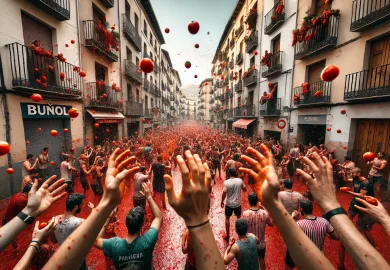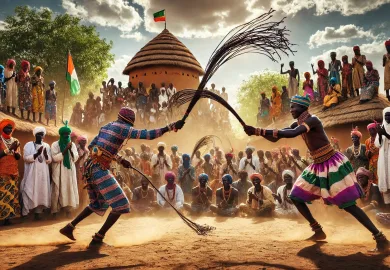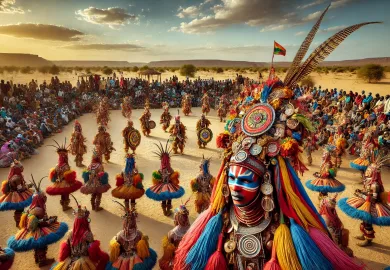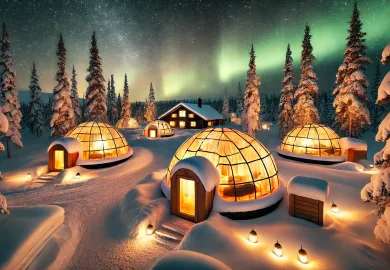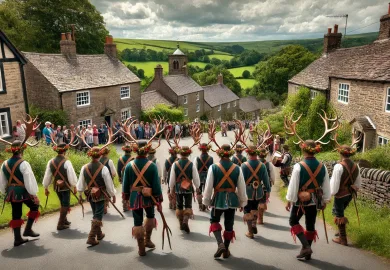
Every year in the heart of Thailand, a unique and colorful festival takes place that attracts tourists from all over the world. The Monkey Buffet Festival, held in the ancient city of Lopburi, is an event unlike any other. This fascinating celebration not only showcases the deep cultural roots of Thailand but also provides a grand feast for the local monkey population, creating a spectacle that is as endearing as it is entertaining.
The Origins and Significance of the Monkey Buffet Festival
The Monkey Buffet Festival, or “งานเลี้ยงโต๊ะลิง” as it is known in Thai, is celebrated annually in Lopburi, a city located about 150 kilometers north of Bangkok. Lopburi is famous for its historical ruins, which are remnants of the Khmer Empire, and for its large population of macaques that roam freely throughout the city. The festival was first introduced in 1989 by a local businessman who recognized the potential of the event to attract tourism while also giving back to the monkeys that are considered sacred and an important part of the city’s cultural heritage.
The significance of the festival goes beyond just feeding the monkeys. In Thai culture, monkeys are seen as symbols of prosperity and good fortune. By offering food to these animals, locals believe they are inviting blessings for the coming year. The festival also honors the monkeys for their role in the Ramayana, an ancient Indian epic that is highly revered in Thailand, where monkeys are depicted as loyal and courageous companions to the hero, Rama.
During the festival, over two tons of fruits, vegetables, and other treats are offered to the monkeys. The event is meticulously planned and funded by local businesses, who see it as both an act of reverence and a way to promote tourism. The monkeys, in turn, delight in the abundance of food, creating a lively and chaotic scene that has become iconic to the festival.
A Day of Feasting and Celebration
The Monkey Buffet Festival is a day-long event filled with activities that keep both the monkeys and the visitors entertained. The festivities typically begin with an elaborate opening ceremony, which includes performances by dancers in traditional Thai attire and sometimes even actors dressed as monkeys to add to the festive atmosphere. The highlight of the event, however, is undoubtedly the grand buffet that is laid out for the monkeys.
Tables are set up in front of the ancient temples and are piled high with a colorful array of fruits such as bananas, watermelons, pineapples, and durians, as well as vegetables and sweets. The food is arranged in artistic displays, often crafted into intricate shapes like pyramids or towers. The sight of hundreds of monkeys descending upon these feasts is both amusing and heartwarming. Some monkeys carefully select their favorite fruits, while others engage in playful antics, fighting over particularly prized pieces or knocking over entire tables in their excitement.
For tourists, this is a unique opportunity to witness the monkeys up close in their natural habitat, behaving as they would if they were not the center of attention. The festival also provides a chance for visitors to interact with the local community and learn more about the cultural importance of the monkeys in Lopburi.
The Role of Monkeys in Thai Culture and Religion
Monkeys hold a special place in Thai culture, particularly within the context of religion and mythology. The Ramayana, known as the “Ramakien” in Thailand, is an epic tale that has influenced much of Southeast Asia’s art, culture, and literature. In this story, the monkey god Hanuman plays a vital role as the loyal servant of Rama, the hero of the epic. Hanuman’s strength, intelligence, and devotion have made him a revered figure in Thai culture, and he is often depicted in traditional Thai art and temple carvings.
Beyond mythology, monkeys are also considered to be bringers of good luck. In many parts of Thailand, feeding monkeys is seen as a meritorious act that can bring blessings and ward off bad fortune. This belief is especially strong in Lopburi, where the monkeys are not just seen as animals but as protectors of the ancient temples and as symbols of the city’s rich history.
The Monkey Buffet Festival is, therefore, not just an event for entertainment but also a deeply symbolic act that ties into these religious and cultural beliefs. By hosting the festival, the people of Lopburi pay homage to the monkeys and ensure that the city remains blessed and prosperous.
Tips for Visiting the Monkey Buffet Festival
If you’re planning to visit the Monkey Buffet Festival, there are a few things to keep in mind to make the most of your experience. The festival usually takes place on the last Sunday of November, so it’s best to plan your trip around this time. Here are some tips to help you enjoy the event:
- Arrive Early: The festival attracts a large number of tourists, so arriving early will give you the best chance to see the monkeys before the crowds gather. You’ll also have more time to explore the ancient ruins and get a good spot for viewing the festivities.
- Dress Appropriately: While the festival is a fun event, it’s important to remember that it takes place in a religious and historical setting. Modest clothing is recommended, especially if you plan to visit the temples. Comfortable shoes are also a must, as you’ll likely be walking around a lot.
- Respect the Monkeys: The monkeys in Lopburi are accustomed to human interaction, but it’s important to remember that they are still wild animals. Avoid making sudden movements or trying to touch the monkeys, as this can provoke them. It’s also a good idea to keep your belongings secure, as the monkeys are known for their curiosity and may try to grab things from you.
- Bring a Camera: The Monkey Buffet Festival is a photographer’s dream, with vibrant colors, ancient architecture, and plenty of action as the monkeys enjoy their feast. Make sure to bring a camera or a smartphone with a good camera to capture the moments.
- Explore Lopburi: While the festival is the main attraction, Lopburi has much more to offer. Take the time to explore the city’s historical sites, such as the Phra Prang Sam Yot temple and the Narai Ratchaniwet Palace. The city’s markets and local eateries are also worth checking out for a taste of authentic Thai culture.
The Monkey Buffet Festival is a one-of-a-kind experience that offers a glimpse into the unique traditions and beliefs of Thailand. Whether you’re a culture enthusiast, a photographer, or just someone looking for an unforgettable experience, this festival is sure to leave a lasting impression.

